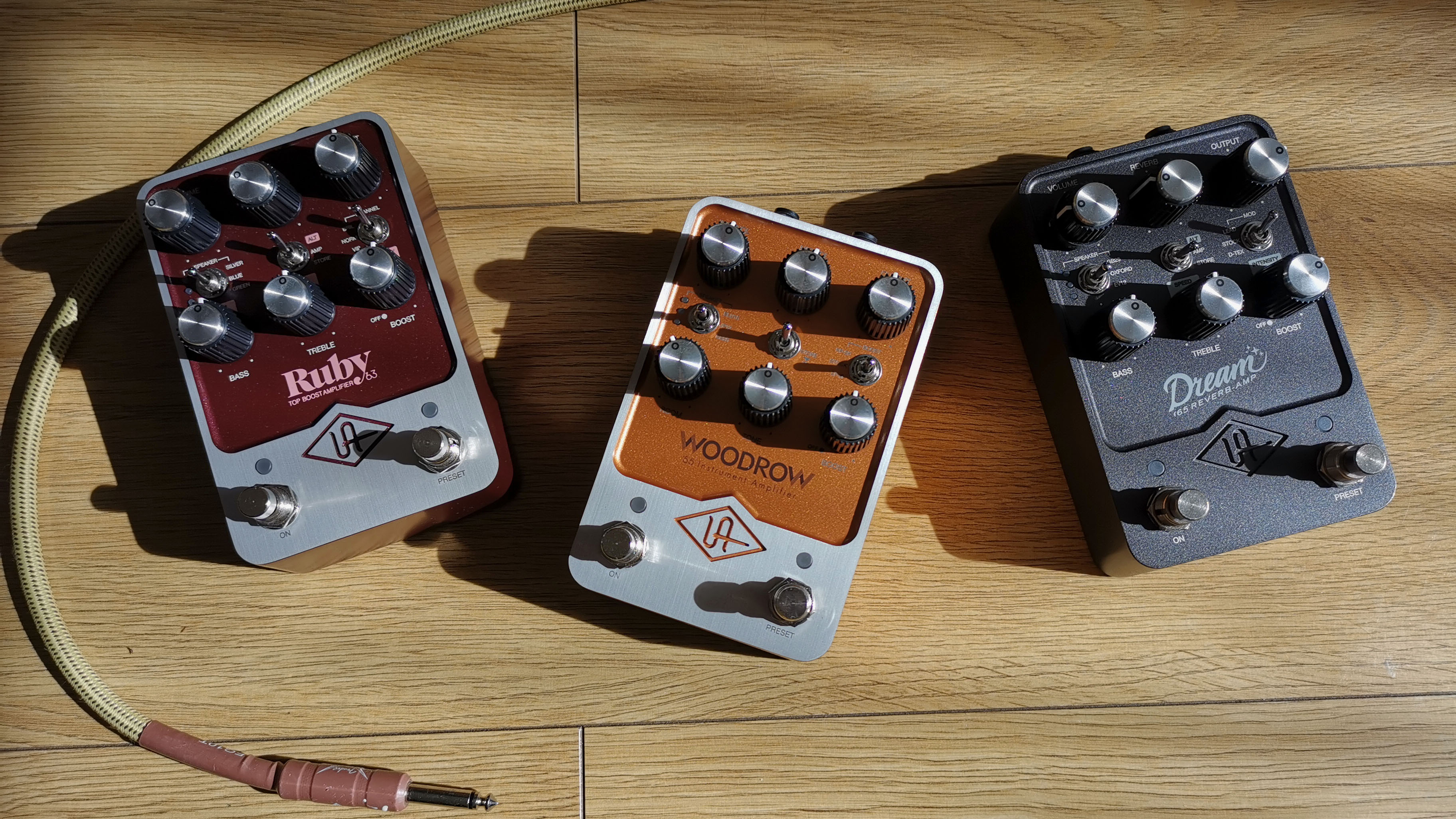MusicRadar Verdict
For what they set out to achieve in terms of classic vintage amp recreation, these pedals are a huge success. Despite some practical features that will be conspicuous to some players by their absence, this is some of the most impressively nuanced amp modelling of tone and touch sensitivity we’ve ever heard.
Pros
- +
Benchmark modelling of detailed amp tones
- +
Stunning valve-like touch dynamics
- +
Great selection of cab models
- +
Excellent option for live and DI recording use
- +
Physical controls work intuitively
- +
Additional boost modes on Woodrow and Dream add versatility
Cons
- -
The lack of designated headphone out is frustrating
- -
No onboard effects loop
- -
No MIDI functionality for enhanced switcher integration
MusicRadar's got your back
What are they?
We like amps, you like amps – guitarists like playing their guitar amps loud. But not all of us can. Not all of us even need them these days, and it’s not an exaggeration to say that the market is now responding to this; big time.
Modelling processors have been offering a multitude of amp and cab options for a while now, but our options for convenience are growing elsewhere too. Because not everyone wants all the options all the time. The concept of the amp pedal for live, recording and practice has been explored further recently by companies including Blackstar, Victory, Walrus Audio, Orange, Strymon, DSM & Humbolt and Two Notes. And not all these options use digital modelling to get there; some have tube-driven preamps. Now Universal Audio has entered the room, and they have their own USP for players. In true UA form it seems a pretty simple proposition, but it’s backed by the details provided by countless hours in their tone lab.
The company is still early in its pedal story; the UAFX delay, reverb and modulation pedals in 2021 were a confident start from a brand already trusted by pros to deliver benchmark plugin tones. There were caveats; the lack of MIDI integration and limited onboard presets compared to the competition. But the sheer quality of the sounds was compelling. The decision to follow-up those units with amp pedals shows just how ambitious UA are about this part of the market; the company's James Santiago, Tore Mogensen and co have put years into what we now have in front of us. Three pedal amps that are very clear in their aims; to accurately model three of the greatest guitar amps in history.

While others combine amp models to create a veritable modelling smorgasbord for your pedalboard, UA has gone the opposite way; the Woodrow ‘55, Dream ‘65 and Ruby ‘63 lean into their Fender Tweed, Fender Deluxe and Vox AC30 inspirations digitally and physically. The pedals recreate the controls of each amp, and even notable mods that appeared on examples later. Their onboard dynamic speaker modelling cabs models seem carefully curated too. And we’ve heard how impressive UA’s modelling is in its OX.
In a world of options is this more focussed modelling hardware approach a case of quality over quantity? As we’ll find out, it’s not always that simple…
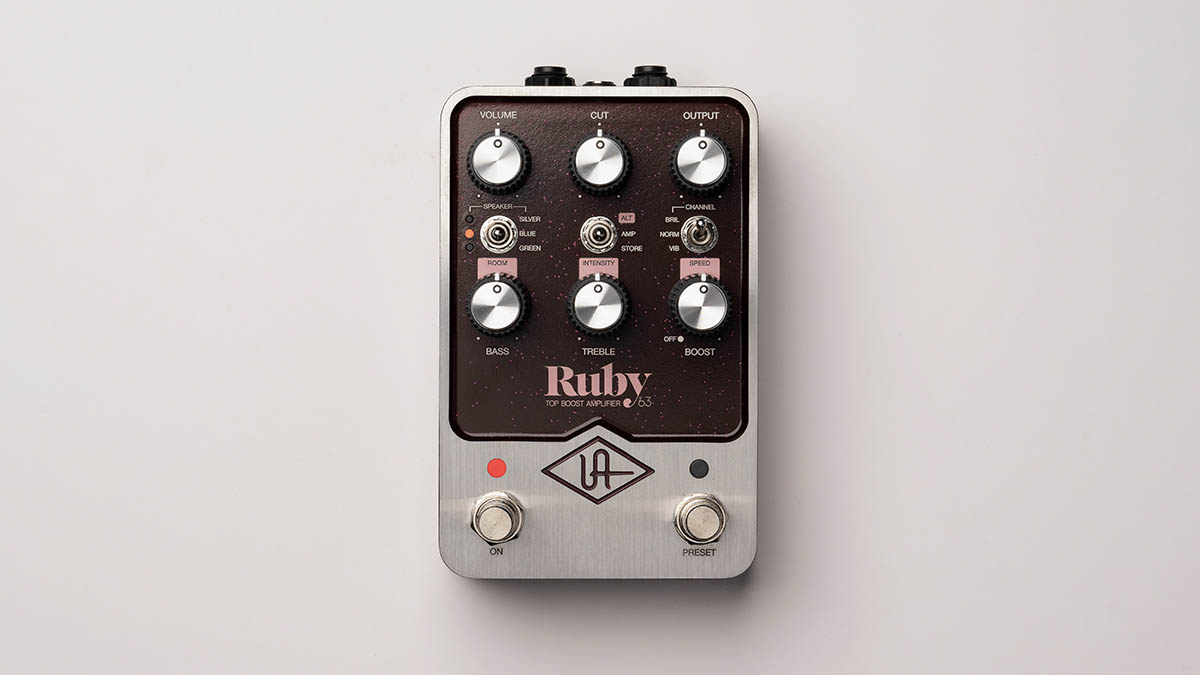
These pedals share the same chassis and basic layout style as the previous UAFX pedals. We are fans of their aesthetic / build quality combination and the same applies here. The Woodrow gets a Tweedy brown with silver combo, the copper hues of the Ruby are evocative. The Dream ‘65 has been a bit cheated of mirroring the full-blown black/silver look of its influence, as we presume it would have looked too much like the previous Starlight Echo Station, but if stealth black is your thing, it’s good news.
In addition to ‘Live’ and ‘Preset’ footswitches that can be assigned to different combinations with the UAFX Control mobile app, the specific functionality of the six main control knobs and three mini switches here varies from pedal to pedal; reflecting the controls on the amps they seek to recreate. For example, while the Ruby features Cut, along with Treble and Bass Cut, with the latter doubling as a Room reverb control, the Dream has a dedicated control for its spring reverb.
Want all the hottest music and gear news, reviews, deals, features and more, direct to your inbox? Sign up here.
It does help to have some background with the original amp controls but reading the included manual will give you the grounding you'll need; a mic volume control on the Woodrow to offer a secondary gain control like the original, but the 'Brilliant' Top Boost and ‘Normal’ AC30s reflected in the channels of the Ruby go further and actually give you the option of the '63 amp and its 1961 predecessor. The Dream ‘65 even has three separate Boost channels that reflect famed modifications, which we’ll get to later.

We’re looking at these pedals one at a time, before drawing our conclusions at the end. Flexibility is a talking point; these pedals are designed to run into an amp’s power amp section using the four-cable method, an active cab with a flat response, a house PA, your USB interface… but there’s no hard and fast rules. You could use them as stompboxes into your amp's input, but that’s not their primary purpose and there’s so many variables your amp choices then impart so we aren’t going to evaluate the pedals in that last scenario.
We’ll be using them going into a Line 6 Powercab in flat mode – so it's comparable with a lot of FRFR options out there – with the pedals on their own and as part of a pedalboard signal chain with a delay pedal, a UA Astra pedal for modulation and different overdrives including a Timmy, EHX Soul Food and TS9 Tube Screamer. We’ll also try them into our USB interface with no additional EQ or compression for recording. And for practice volumes we’re also trying a Positive Grid Spark 40 set to a flat response acoustic amp setting (usually a good way of using a practice amp with a modeller in our experience). We’ve got guitars with PAFs, Strat single-coils, P-90s and even Firebird pickups to try too to give us a good sense of how the pedal's tones react.
Woodrow ‘55
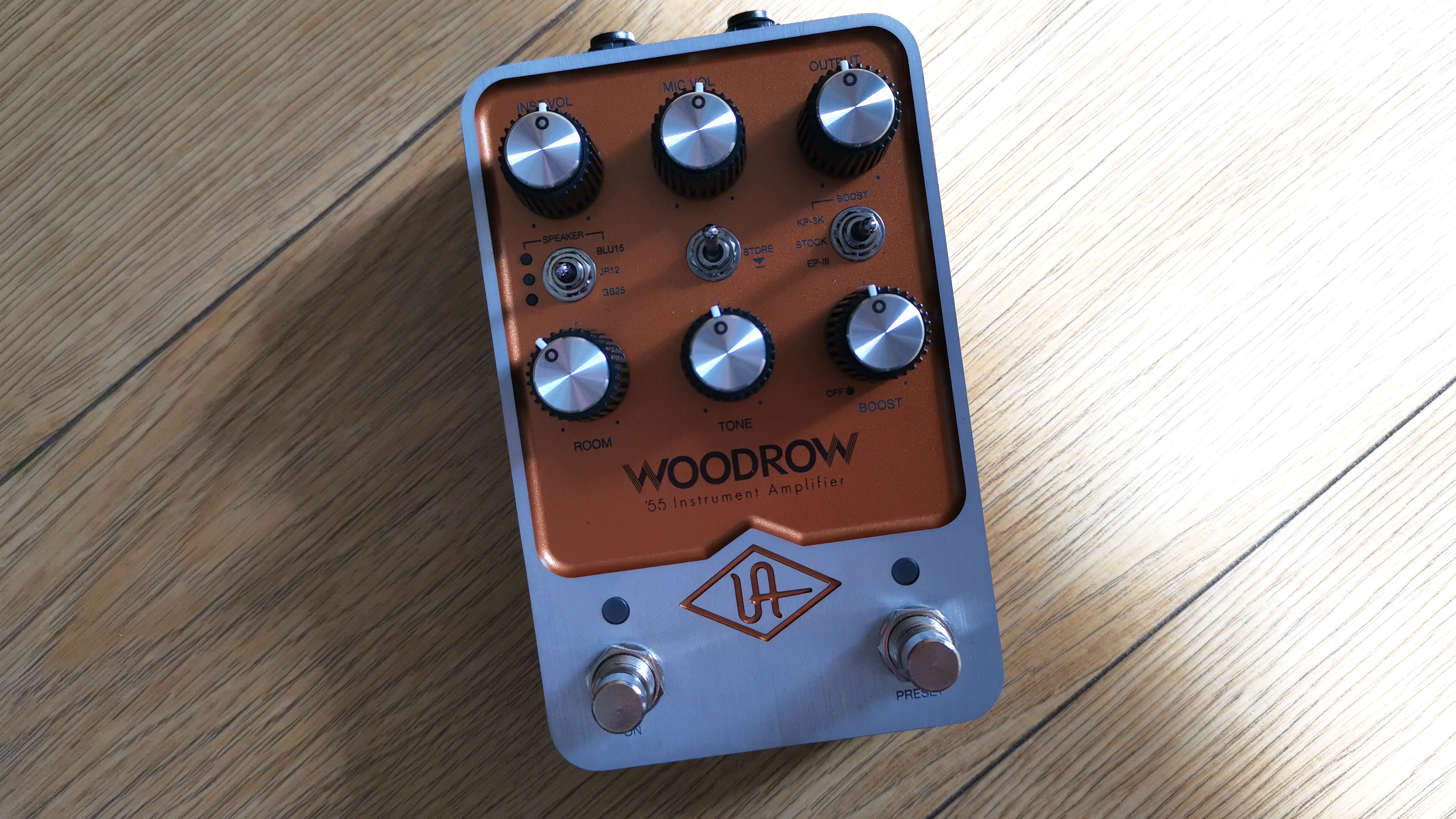
Looking at the initial coverage of these pedals, there’s a danger that the Woodrow could be overlooked next to the perceived wider appeal of the other two models. And that would be a shame, because the Fender Tweed hasn’t found itself in the collections of world class producers, as well as players like Joe Bonamassa and Billy Gibbons by accident.
Digitally, the ‘55 Tweed Deluxe also already has a reputation as a go-to UA plugin for recording – just ask Myles Kennedy, who was so impressed with it he went out and bought a vintage original. This is the pedal manifestation of the 5E3 narrow panel Tweed Deluxe, made between 1955 and 1960 and loved by Larry Carlton, Neil Young, Mike Campbell and Daniel Lanois, or at least we hope it is. And the original’s surprising depths for clean complexity all the way to beautifully broken drive extremes are something all players should experience. So is this a ticket in?
First we updated to the latest firmware via our Mac and register the pedal (and the other two) so we can access all the features of the UAFX mobile app that connects to the pedals via Bluetooth. We recommend you do this first as it will give you three extra cab models for each pedal; these show as green LEDs, compared to the stock factory models’ red. But you’ll also get access to an array of factory and artist presets via the app that are great for a fast track tour of the variety of tones on offer here. And you may be surprised how wide that is. There’s also a useful function to set the roles of the two foot switches, that will come into play as we go.
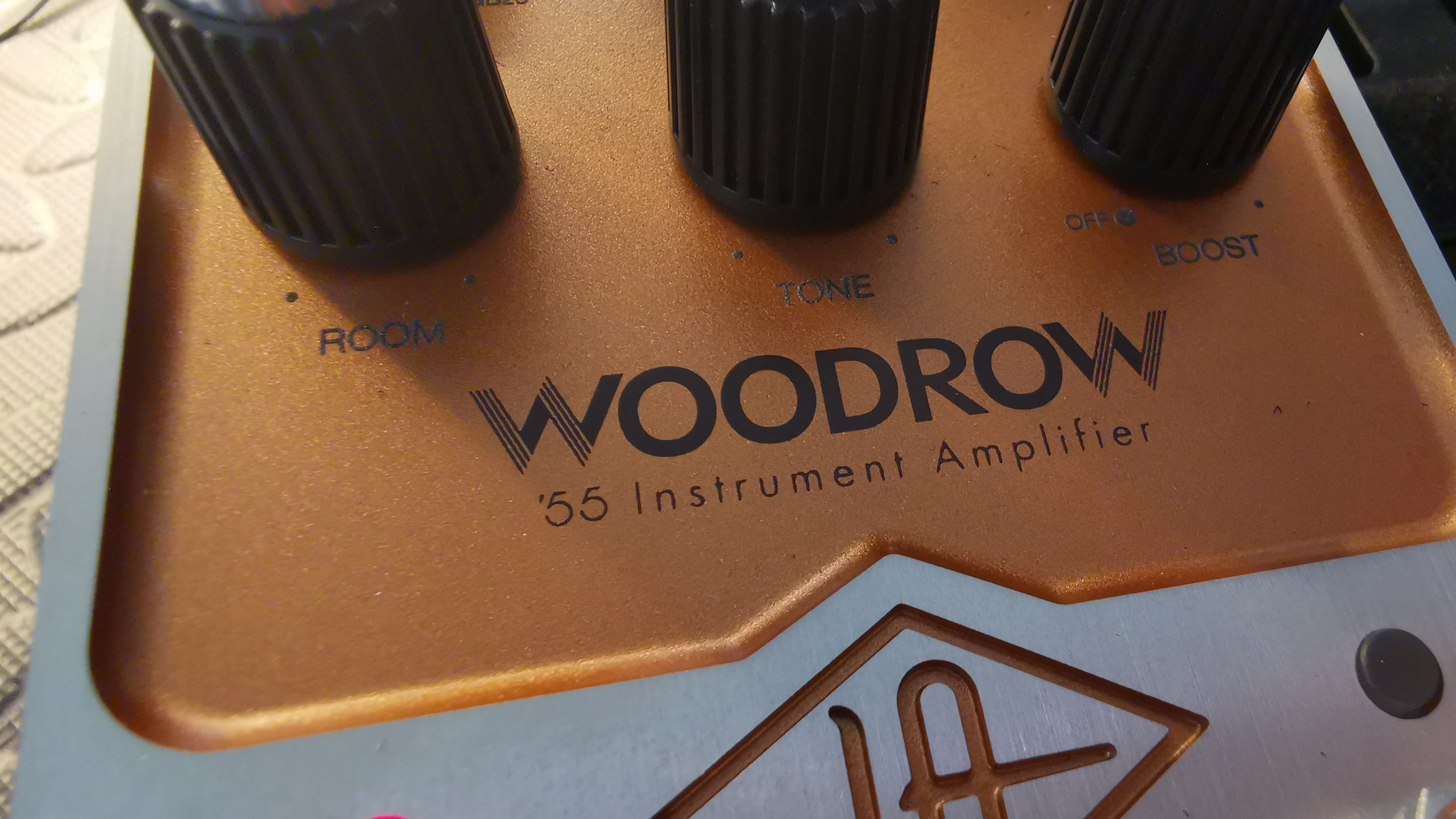
The Woodrow’s instrument and mic volumes are different to the usual amp gain setup; and are the key to unlocking the versatility here. They’re not switchable channels you can access separately in a traditional sense. You can set the pedal up via the app to dial in two distinct blends or turn either down to off. Perhaps set one scenario as a preset and switch between. And we should note now, you only get access to one stored preset on the pedal – though the app will log your previous ones should you wish to recall them.
Starting with a warm, clean tone dialled in and moving through the gain curve, it becomes clear that UAFX have done their R&D. With the instrument volume for grittier gain and the mic for low end warmth, what’s first apparent is the sense of response to our picking dynamics in that crucial edge of breakup territory. Even through the Spark we start to forget we’re using a pedal. And it sounds full; through the Powercab and loud there’s this unmistakable sense as we control the gain with our LP Jr-style guitar with the volume knob – and it’s of a Tweed amp!
Yes, an active cab is helping with that sensation, but what’s crucial is the deeper dive UA have taken here; the cabs all have their roles to play. From the snappier high end character of the JP12 that helps our PAF-loaded Fender's chords ring out for classic rock to the rounder, rootsier character our Strat neck pickup could explore. Newcomers will begin to understand why studio musicians take such a shine to Tweeds.

We can’t resist turning up the Boost and two volumes to go into extremes where the Woodrow sounds like it’s just about holding together
Then there’s the pairings with the three boost options. For us, these are a vital strength for helping to create the ultimate Tweed modelling experience; alongside the stock setting, the toggle switch can select an EP-III boost based on the Echoplex preamp section (a tape delay modelled by UA in the Starlight Echo Station and also the inspiration for a standalone Dunlop preamp pedal) as well as the KP-3K based on the preamp of the Korg SDD-3000 delay, a unit held dear by the Edge. It’s a canny move that underlines the deeper dive UA are taking with standalone amp pedals.
The KP-3K leans towards more mid, the stock great for higher end, full chords and the EP-III bringing toasty warmth, that responds well to our EHX Soul Food. Indeed, they all do, taking us into more of a Marshall territory. We can even get quite Sabbathy with our P-90.
We can’t resist turning up the Boost and two volumes to go into fuzzy extremes where the Woodrow sounds like it’s just about holding together. It’s a glorious sound! And for anyone who wants the ragged glory of Neil Young, this is the pedal to hone in on.
Ruby ‘63

Moving on several years over the Atlantic we come to another iconic amp. And we’ll come out and say it early, these are some of the best Vox AC30 modelled tones we’ve encountered. At times it’s scary how close it gets, and the pedal is a great tour of the range of tones that makes the AC30 such an important amplifier in music history. Yes, those Brian May riff tones are here.

The Bass and Treble controls of the Top-Boost AC30 will wrong-foot Vox newcomers because they are cut controls and as you dial them in you’re taking away rather than adding. Then there’s a separate Cut control, that’s cutting a different frequency of high end. The Treble's tone stack and Cut need to be explored together to get the top end results you desire – but they can only be done so on one of the pedal's three amp channels. Let us explain…
There's three channels available; and two of them reveal this pedal is actually two AC30s in one. The Normal channel is based on the 1961 non-top-boost AC30 and the Boost control adds a germanium treble booster circuit to the amp’s input. The second is our favourite; the Brilliant channel, based on a '63 Top-Boost AC30 that utilised an additional tube for increased gain and treble. The Boost also sees the second appearance of the EP-III tape echo preamp we heard on the Woodrow.
A third Vibrato mode is a standalone channel drawn from the Top-Boost AC30. And it's worthy in its own right; shifting from pulsating tremolo to slower Uni Vibe territory with Speed, Intensity and Room controls available with a flick of the middle switch to ALT mode.

It sounds huge
Between Normal and Brilliant you have all the Voxy goodness you could ever want from a little box. Dig in, soar and enjoy a trip through boxy vintage drive, crunchy chime and bright cleans with a wide cab selection that will mean you always have the right tone for your recordings – or turn the cab off if you have another device's IR to try.
The relative brightness of the modded Celestion Blue – part of the trio of extra cabs you get when registering the pedal via the app – is especially effective combined with medium gain using the Brilliant channel, then using our EHX Soul Food or the Walrus Ages to push it into heavier places. It sounds huge. Of course you can turn the cab models off, and run it into a processor with its own IRs (we tried an AC30 IR on our Powercab too) but there’s plenty of variation in the box here to keep you occupied.
So it's important to reiterate that in Normal mode the controls remain true to the original amp; Bass and Treble cut are inactive. There's less EQ versatility but it doesn't break up as easily as the Brilliant Mode and provides a good platform for overdrive pedals.

We’re quite partial to the mid-gain territory of an AC30 and the sense of pick dynamic shines here
Again you can configure the footswitches in the app for your needs; as a bypass, activate the Boost with the left switch, and alternate between Live and Preset with the right. We’re quite partial to the mid-gain territory of an AC30 and the sense of pick dynamic shines here, especially at rehearsal volume where digital modelling really gets tested.
And for those who want to use the 4-cable method to bypass their amp’s preamp to use these pedals with their power amp section, the app’s 4-Cable Mode can be activated. This lets you switch between your amp’s preamp section and the UAFX pedal – effectively giving you an extra channel that happens to be a whole other amp. You’ll just need an amp with an effects loop.
Dream ‘65

While you might view the Ruby as the all-rounder here, the Dream can get spicier than you might expect without outside help
The concept of a ‘pedal platform’ amp is often tied with clean headroom. But the Dream ‘65 has additional aces up its sleeve in addition to the core Fender Deluxe features of a spring reverb – that positively drips as you turn the dial – and watery tremolo. So we know what pedal the surf players will be buying at least! But we discovered far more via the three boost models here, suggesting this might be the one to buy for those looking for a versatile pedal amp to use alongside other stompboxes.
All three of these pedals impressed us with our overdrive pedals running into them; extending their range with a Timmy, Klon or Tube Screamer. They reacted like the real thing as we turned them up to gig levels as part of a signal chain, cleaned up well with our guitars’ volume controls. And while you might view the Ruby as the all-rounder here, the Dream can get spicier than you might expect without outside help.
If some players imagine Deluxes as cleaner machines, they might be surprised by how early this breaks up humbuckers. But the jangle and crystalline goodness are here alright when you crank up the Output and turn the input Volume down.
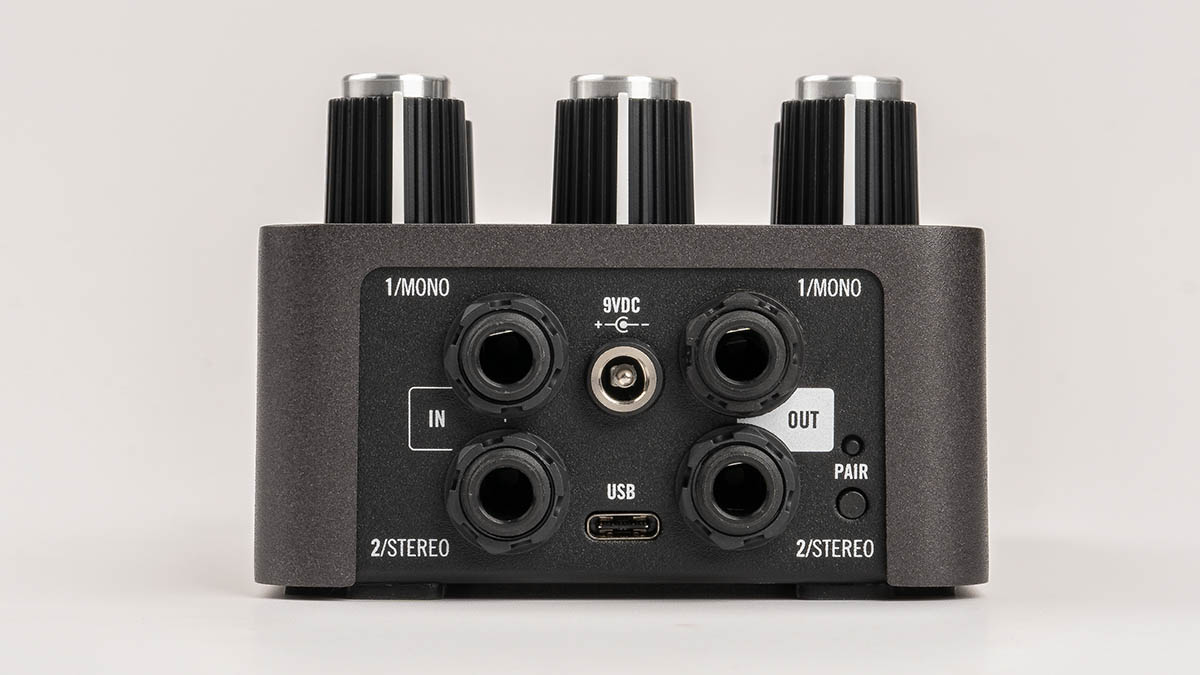
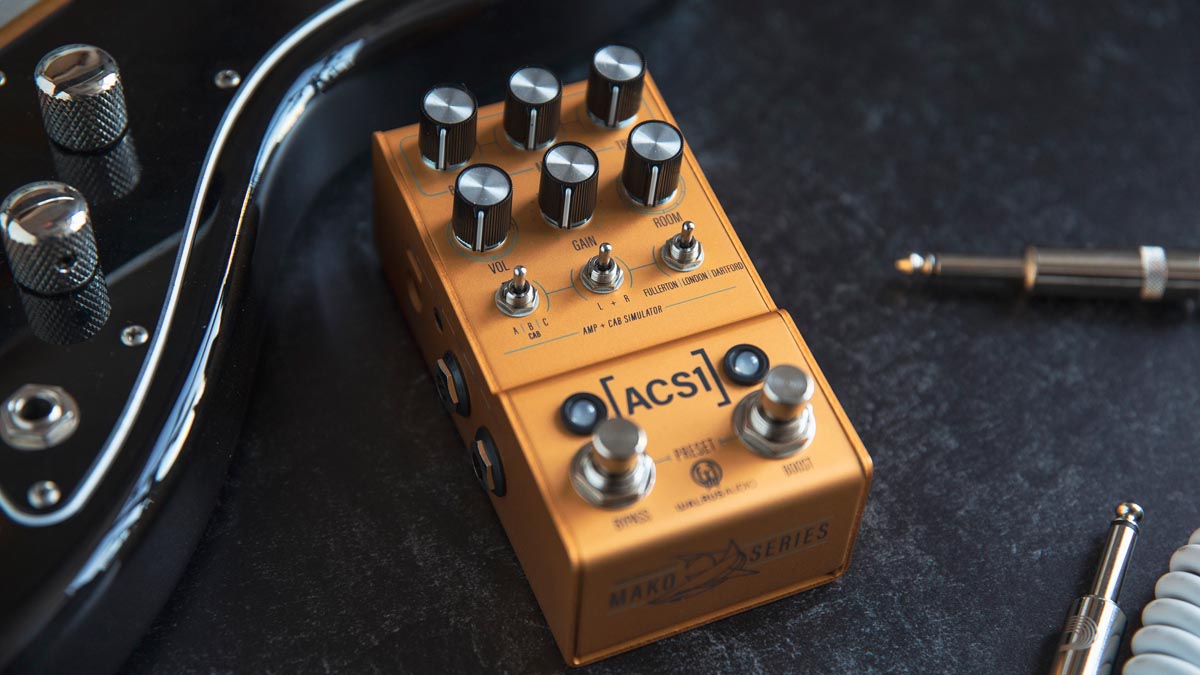
• Walrus ACS1
An amp and cab simulator with a Fender, Vox and Marshall-style models and a selection of cabs. Great sounds and response – plus a dedicated headphone-out and the option of using two of the amp models in stereo.
Excellent Marshall, Fender and Vox-based models here too, plus the option to upload your own IRs. Like the Walrus, there's MIDI control and headphone-out, plus you can shut off the amp or cab simulator and use each on its own.
• Blackstar Dept 10 Dual-Drive
The preamp here is valve-driven but the cabs are digital, thanks to Blackstar's highly-editable Cab Sim software. If you want higher gain capability and and a two-channel pedalboard amp at a great price, look not further.
The classic '60s stock Oxford speaker model is a greater place to start; vibrant and sparkly. The spring reverb – the same algorithm as used the Golden Reverberator – can get very drippy so we start low. Like the tremolo, it can be set to footswitch activation and that could save some players an additional pedal or two on the ‘board.
The Dream ‘65 makes the most of the UAFX Control app’s ability to assign functions to create a versatile foot-switchable amp. We ended up using a clean preset with switchable boost and a live overdrive with the same, covering a lot of ground in the process and setting the reverb level higher in clean mode with the Oxford speaker. Then we used the bonus 4x10 Super Reverb-style bonus cab model for our overdrive (the rest are 12” speaker models). Hey presto; we have a two-channel amp with boosts.
We're pretty open-minded with menu systems but setting and tweaking all just this feels so intuitive with the physical controls that reflect a Deluxe amp's. This approach could appeal to many players put off by processor LCD screens; those who are more inspired by the hands-on immediacy of stompboxes.

The versatility is enhanced further by those boost mods; both quite different. The Stock offers a clean preamp boost, the Lead is the Dumble ‘80s Overdrive Special mod and the DTEX is based on the mod for Stevie Ray Vaughan by the late César Díaz. In this latter boost mode, tremolo can’t be dialled in – just like it can't with the mod on the real thing. Using these boosts reflects UA’s skills in recreating tube-like medium and sometimes gritty crunch tones. Though the Dumble mod gives a smoother mid boost that’s useful for cleans too, the lower end boost of the DTEX can actually get into fuzz pedal territory when pushed, while retaining high end chime in chords.
It’s the closest we’ve ever got to the real thing with modelling technology
This sounds a showcase of the best of a Fender Deluxe, beyond 1965 too, and it’s surprisingly versatile because of it. It’s also the closest we’ve ever got to the real thing with modelling technology. Such is its response, the Dream will make you play with more sensitivity, and like the real thing, it will often lay sloppy technique bare. But we all need a bit of that, right?
Verdict

Not everyone is romantic about real valves, and not everyone can or wants to spend £1,500 on a new combo
There’s something truly special, and sometimes sacred, about the feel and sound of playing through a good tube amp, and there’s also scenarios where that isn’t practical, or even possible. But here’s the thing; open-mindedness goes a long way these days. And not everyone is romantic about real valves, and not everyone can or wants to spend £1,500 on a new combo – let alone what a vintage example costs. Of course, there's room for both – why choose between them if you don't have to? But there’s also the other side of the potential audience; the people with modelling processors who keep going back to the same amp and cab model for their tone.
These three pedals represent some genuine versatility within and around their individual blueprints. And we’ve played them in rehearsals with a band through an active cab and then recorded with them through our DAW. They’ll ‘push air’, and they’ll also allow you to dial in great sounds for tracking with low noise. In real world use they soon became second nature as the catalysts of our tones. And in a real world of options, we actually admire UA presenting new specific flavours of choice and saying; if you want one of these classic amps in a pedal, we’ve got you covered. And we’ve talked about what these pedals do, but there’s also things they don’t too.

UAFX are still not embracing MIDI functionality
All three are missing features that compromise some flexibility for us; and the biggest is there’s no dedicated headphone out. We think that’s an underestimation of home players’s needs – surely the major target market here. And we include ourselves. We've heard of a workaround players are trying with a Y cable running from the stereo outputs. But that's not mentioned in the manuals or officially supported by UA, and it isn't the same as a designated headphone-out.
Like the previous three pedals, UAFX are still not embracing MIDI functionality; making their compatibility with switchers a sore point that could turn some players off before they’ve even tried them. There’s also no onboard effects loop either; limiting that 'amp-in-a-pedal' integration option with time-based effects many players favour. Not such a deal breaker if you’re happy with the onboard reverb options these pedals offer.
And then there’s our third point, and it’s a minor one in context; with pedals that feel like the hardware evolution of a UA amp plugin, why can we not record with them via USB? We understand the company want to sell their acclaimed interfaces too but would it not be easier to remove the middle device here for guitar players? We asked UA about this and the company responded as follows: ‘Using the pedals as an interface is simply outside the scope of the project,' it says. 'Our goal with UAFX is to create classic stomp boxes with UA quality sonics. As you noted, we have multiple lines of interfaces that can pair with them for awesome recording setups, so we recommend users check them out.’
And yet despite these gripes, the sounds and response here are so good we actually don’t find the combination of the above dealbreakers. The tones and crucial feel of playing through these pedals made us forget this is modelling. We were simply enjoying playing through them – the way it should be with any great gear.
The Dream ‘65 especially ticks the boxes for us as an ideal platform for a pedalboard rig because of its clean prowess that offers substantial depth, with a reverb and tremolo that may even give your Strymon Flint a worried look if your pedalboard is looking cramped. Along with those distinct boost modes, it seals the deal for versatility.

We think these pedals also raise a question; how many amps do you really need, or actually want?
The Woodrow is the darker horse of the trio thats appeal will unsurprisingly depend on your love of the Tweed's character, and some of its appeal for fans is the fact it's a relatively small physical valve amp. But it isn't a small price either; a new Fender 57 Deluxe is around £2000 / $2400. We found a lot of tones to mine in this faithful recreation in a pedal – and we love the raucous, rootsy drive it can offer.
The Ruby sets the new standard for AC30 modelling for us; it just sounds like a great example of the iconic British combo with the flexibility of a stompbox. And it really hones in on what we see as the sell here; because these pedals attempt to model every facet of the amps as much as the technology allows, they are not in competition with the wider model options of multi-effects amp processors.
So you need to know if these are the kind of sounds you want; and if any of these fit that bill, you’re in for a treat. We think these UAFX amp emulators also raise a question; how many amps do you really need, or actually want? This trio each offer the range and versatility to offer compelling solutions as the basis for your tones and that quality is worth the price for us.
For those who want a quiet stage and go direct to PA, or want a lighter fly rig, these pedals are going to be especially alluring. We think worship players especially will want to check out the Dream ‘65 and Ruby ‘63.
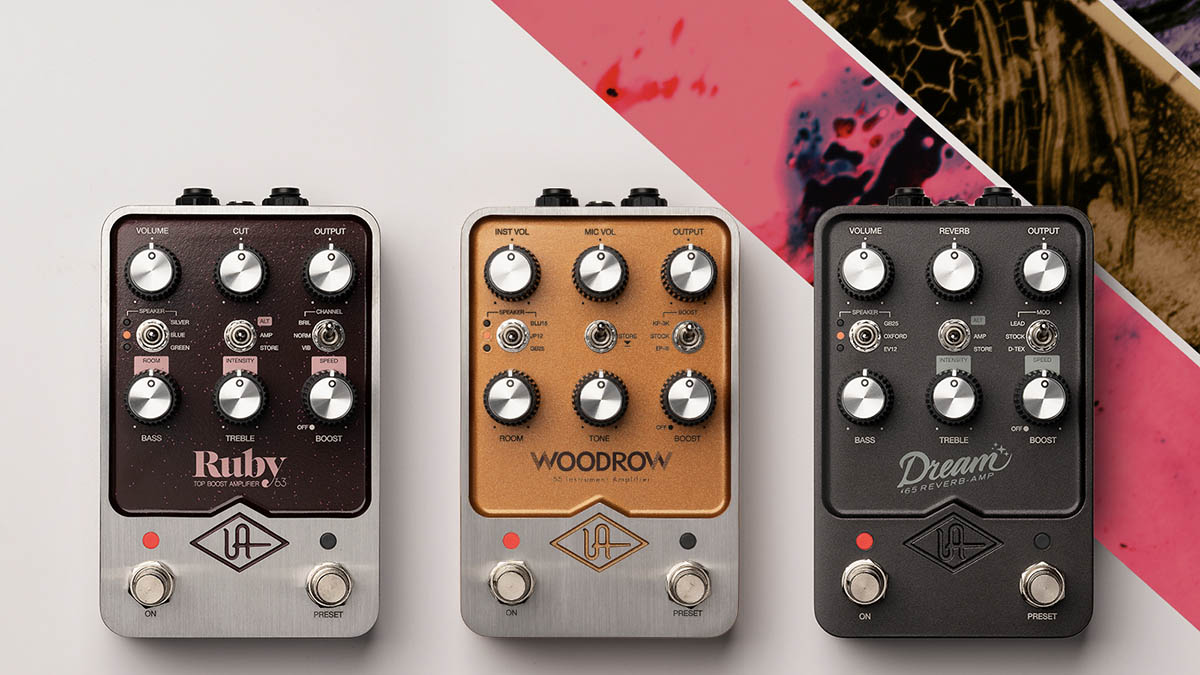
If you want these specific amp sounds, we think these are the best pedal-based options for them right now
If you want to keep your options more open with pedal amps that embrace simpler tactile controls over menu screens, there are very good options out there with multiple models built in. Is it fair to compare this trio of deeper, more detailed amp recreations with pedals that aren’t honing in so specifically on one specific model? It depends what you’re looking to get for your money; what you need in your home recording setup and what you want for gigging and home playing.
If you want these specific amp sounds, we think these are the best pedal-based options for them right now. We’re looking forward to hearing what amps UA might be eyeing for the treatment next… JCM800? Soldano SLO? Blesbreaker? Bring 'em on!
MusicRadar verdict: For what they set out to achieve in terms of classic vintage amp recreation, these pedals are a huge success. Despite some practical features that will be conspicuous to some players by their absence, this is some of the most impressively nuanced amp modelling of tone and touch sensitivity we’ve ever heard.
What the web says
"Since most of the modelling world seems to be in an arms race to offer more amps, effects, IRs, connectivity and controllers, these are a bit of a statement! UA appear to be calculating that there are players who weigh up the price, facilities and, above all, sound balance quite differently, and I think they might be right."
Altogether, then, has Universal Audio got it right with these new “amp in a box” additions to the UAFX line? From my brief experience with them, I would say a very solid yes! The quality of tone, feel and accuracy of recreation is deeply impressive. The ability to use these pedals direct for recording/live use, or incorporate them into your amp rig adds extra value.
"Captures the sound and feel of a real AC30 in every conceivable detail – this is an absolute joy to use."
Hands-on demos
Rabea Massaad
Working Class Music
Corey Congilio
Leo Gibson
Andertons
Vintage King
Specifications
Woodrow '55
• CONTROLS: Instrument Volume, Mic Channel Volume, Output, Room (reverb), Tone, Boost; 3 x toggle switches for Speaker cab type, preset store and boost type; preset and bypass footswitches
• FEATURES: USB-C for app control and updates, Mono/stereo inputs and outputs, Bluetooth for app control; switchable true or buffered bypass (via app)
• POWER SUPPLY: 9-volt mains supply only (minimum 400mA, not included)
• DIMENSIONS: 148 x 92 x 65mm
Ruby '63
- CONTROLS: Volume, Output, Cut, Bass / Room (reverb), Treble / (vibrato) Intensity, Boost / (vibrato) Speed, Speaker cab select switch, Control mode switch: ALT / Amp / Preset store mode; Channel select switch; bypass and preset footswitches
- FEATURES: USB-C for app control and updates, Mono/stereo inputs and outputs, Bluetooth for app control; switchable true or buffered bypass (via app)
- POWER: 9-volt mains supply only (minimum 400mA, not included)
- DIMENSIONS: 148 x 92 x 65mm
Dream '65
• CONTROLS: Volume, Reverb (spring), Output, Bass, Treble / (tremolo) Speed, Boost (tremolo) Intensity, 3 x mini switches: speaker cab sim type, ALT / Amp / Preset store, Boost type.
• FEATURES: USB-C for app control and updates, Mono/stereo inputs and outputs, Bluetooth for app control; switchable true or buffered bypass (via app)
• POWER SUPPLY: 9-volt mains supply only (minimum 400mA) (not included)
• DIMENSIONS: 141 x 92 x 65mm

Rob is the Reviews Editor for GuitarWorld.com and MusicRadar guitars, so spends most of his waking hours (and beyond) thinking about and trying the latest gear while making sure our reviews team is giving you thorough and honest tests of it. He's worked for guitar mags and sites as a writer and editor for nearly 20 years but still winces at the thought of restringing anything with a Floyd Rose.
